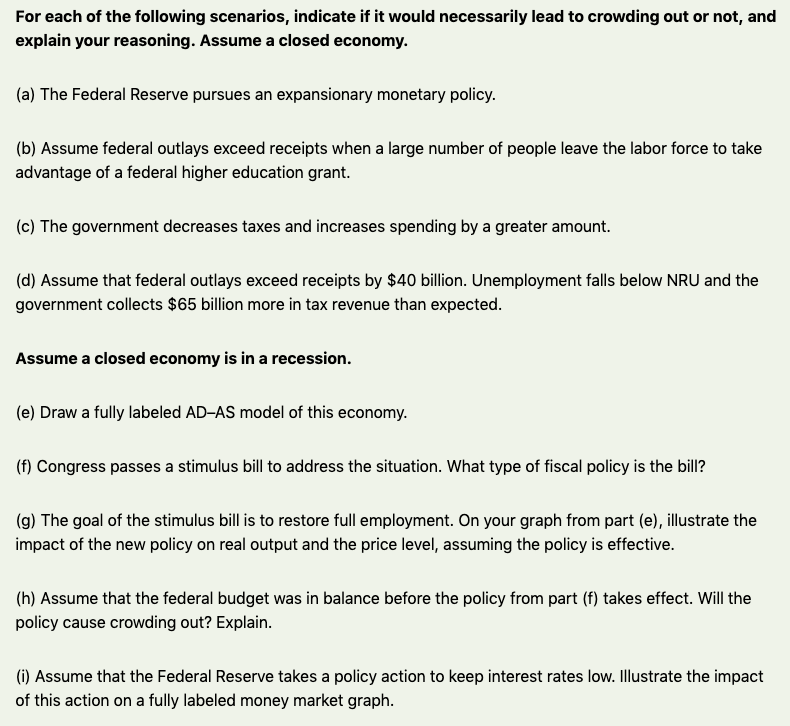For each of the following scenarios, indicate if it would necessarily lead to crowding out or not, an explain your reasoning. Assume a closed economy. (a) The Federal Reserve pursues an expansionary monetary policy. (b) Assume federal outlays exceed receipts when a large number of people leave the labor force to take advantage of a federal higher education grant. (c) The government decreases taxes and increases spending by a greater amount. (d) Assume that federal outlays exceed receipts by $40 billion. Unemployment falls below NRU and the government collects $65 billion more in tax revenue than expected. Assume a closed economy is in a recession. (e) Draw a fully labeled AD-AS model of this economy. (f) Congress passes a stimulus bill to address the situation. What type of fiscal policy is the bill? (g) The goal of the stimulus bill is to restore full employment. On your graph from part (e), illustrate the impact of the new policy on real output and the price level, assuming the policy is effective. (h) Assume that the federal budget was in balance before the policy from part (f) takes effect. Will the policy cause crowding out? Explain. (i) Assume that the Federal Reserve takes a policy action to keep interest rates low. Illustrate the impact of this action on a fully labeled money market graph.
For each of the following scenarios, indicate if it would necessarily lead to crowding out or not, an explain your reasoning. Assume a closed economy. (a) The Federal Reserve pursues an expansionary monetary policy. (b) Assume federal outlays exceed receipts when a large number of people leave the labor force to take advantage of a federal higher education grant. (c) The government decreases taxes and increases spending by a greater amount. (d) Assume that federal outlays exceed receipts by $40 billion. Unemployment falls below NRU and the government collects $65 billion more in tax revenue than expected. Assume a closed economy is in a recession. (e) Draw a fully labeled AD-AS model of this economy. (f) Congress passes a stimulus bill to address the situation. What type of fiscal policy is the bill? (g) The goal of the stimulus bill is to restore full employment. On your graph from part (e), illustrate the impact of the new policy on real output and the price level, assuming the policy is effective. (h) Assume that the federal budget was in balance before the policy from part (f) takes effect. Will the policy cause crowding out? Explain. (i) Assume that the Federal Reserve takes a policy action to keep interest rates low. Illustrate the impact of this action on a fully labeled money market graph.
Macroeconomics: Private and Public Choice (MindTap Course List)
16th Edition
ISBN:9781305506756
Author:James D. Gwartney, Richard L. Stroup, Russell S. Sobel, David A. Macpherson
Publisher:James D. Gwartney, Richard L. Stroup, Russell S. Sobel, David A. Macpherson
Chapter12: Fiscal Policy, Incentives, And Secondary Effects
Section: Chapter Questions
Problem 5CQ
Related questions
Question
Please do GH and I !!!

Transcribed Image Text:For each of the following scenarios, indicate if it would necessarily lead to crowding out or not, and
explain your reasoning. Assume a closed economy.
(a) The Federal Reserve pursues an expansionary monetary policy.
(b) Assume federal outlays exceed receipts when a large number of people leave the labor force to take
advantage of a federal higher education grant.
(c) The government decreases taxes and increases spending by a greater amount.
(d) Assume that federal outlays exceed receipts by $40 billion. Unemployment falls below NRU and the
government collects $65 billion more in tax revenue than expected.
Assume a closed economy is in a recession.
(e) Draw a fully labeled AD-AS model of this economy.
(f) Congress passes a stimulus bill to address the situation. What type of fiscal policy is the bill?
(g) The goal of the stimulus bill is to restore full employment. On your graph from part (e), illustrate the
impact of the new policy on real output and the price level, assuming the policy is effective.
(h) Assume that the federal budget was in balance before the policy from part (f) takes effect. Will the
policy cause crowding out? Explain.
(i) Assume that the Federal Reserve takes a policy action to keep interest rates low. Illustrate the impact
of this action on a fully labeled money market graph.
Expert Solution
This question has been solved!
Explore an expertly crafted, step-by-step solution for a thorough understanding of key concepts.
This is a popular solution!
Trending now
This is a popular solution!
Step by step
Solved in 3 steps with 2 images

Knowledge Booster
Learn more about
Need a deep-dive on the concept behind this application? Look no further. Learn more about this topic, economics and related others by exploring similar questions and additional content below.Recommended textbooks for you

Macroeconomics: Private and Public Choice (MindTa…
Economics
ISBN:
9781305506756
Author:
James D. Gwartney, Richard L. Stroup, Russell S. Sobel, David A. Macpherson
Publisher:
Cengage Learning

Economics: Private and Public Choice (MindTap Cou…
Economics
ISBN:
9781305506725
Author:
James D. Gwartney, Richard L. Stroup, Russell S. Sobel, David A. Macpherson
Publisher:
Cengage Learning

Macroeconomics: Private and Public Choice (MindTa…
Economics
ISBN:
9781305506756
Author:
James D. Gwartney, Richard L. Stroup, Russell S. Sobel, David A. Macpherson
Publisher:
Cengage Learning

Economics: Private and Public Choice (MindTap Cou…
Economics
ISBN:
9781305506725
Author:
James D. Gwartney, Richard L. Stroup, Russell S. Sobel, David A. Macpherson
Publisher:
Cengage Learning